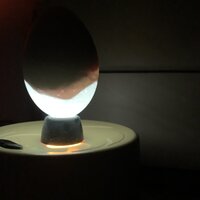I think that refers to shipped eggs with severe air cell damage leading to them being misshapen. Where did you read this? It's been a long time since I did research on what other people recommend. They could have a good reason behind it, I dunno.
The point of laying them down is so that any liquid in the air cell runs away from the pip instead of towards it. This won't apply to severely saddled eggs as much. Eggs on their sides are supposed to be oriented with the lowest dip in their air cell (as seen from a vertical position) upwards. This may not always be apparent until drawdown, which is when the air cell tilts strongly to one side as the bird moves to make an internal pip. I've hatched both ways, and didn't notice an effect on hatch rates... so you can do either, honestly, though I'm not sure how the sub-optimal air cell sizes seen in your pics will impact things. Personally, I lay all my eggs down to hatch, even the shipped eggs, of which I hatch quite a few yearly. That's a subjective thing, though.
For future reference:
View attachment 2129964
No, I wouldn't. What day are they on now? I raise the humidity to about 55% as soon as I see drawdown or an internal pip. Low humidity for hatch risks slow hatchers becoming stuck. I run humidity at about 30% for the first 18 days, though that's quite a subjective level and you should use whatever gives your eggs the best air cell development.
You can if you want to, turning isn't that necessary past day 13--14, if my memory holds. The blood clots don't have a bearing on whether to turn them, in my experience. You should stop turning by day 18 so the chicks can orient themselves properly.
https://www.backyardchickens.com/articles/guide-to-assisted-hatching-for-all-poultry.72886/
Here's a good link on that. I err on the side of caution and only assist if I'm sure the bird needs it. Personally, I won't assist any egg that hasn't internally pipped. It's just not worth it, to me.
 With manually rotating these shipped eggs. All had saddle air cells or detached air cells. I’ve been tilting them in their egg carton 90 degrees in AM side to side and 90 degrees in PM bank to front...6 times. I count 1, 2, 3, 4, 5, 6 so each side is tilted 3 times.
With manually rotating these shipped eggs. All had saddle air cells or detached air cells. I’ve been tilting them in their egg carton 90 degrees in AM side to side and 90 degrees in PM bank to front...6 times. I count 1, 2, 3, 4, 5, 6 so each side is tilted 3 times.






















































